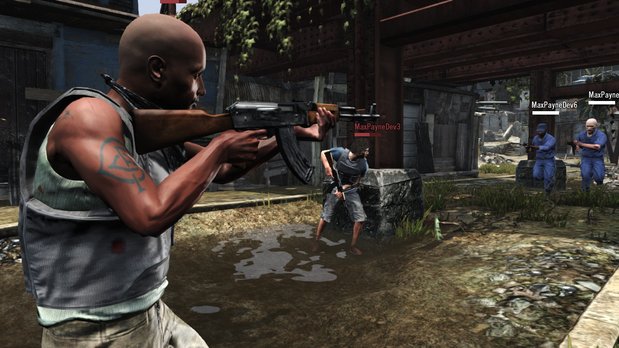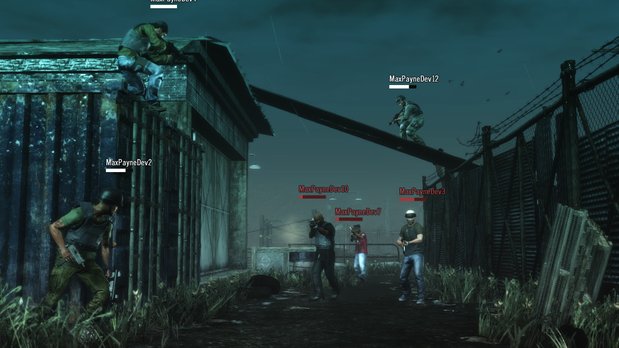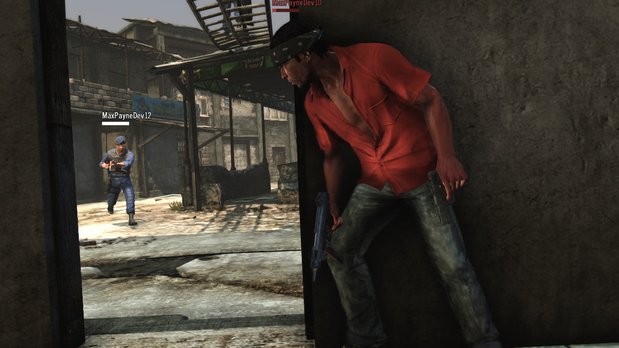Max Payne 3 hands-on with Gang Wars, Payne Killer and multiplayer Bullet Time
We shootdodge our way through eight- and 16-player matches as Max, Raul and some of Brazil's most vicious gangs
Judging from what we’ve played so far, Max Payne 3 seems to do an admirable job of preserving the feel and rhythms of its more old-school predecessors. However, it’s also bringing a lot of modern tropes to the series, including sticky cover, (optional) lock-on aiming, and (perhaps most unexpected of all) multiplayer. We recently got a chance to dive into said multiplayer (headfirst and in slow motion with both guns blazing), and we found that – far from being a tacked-on set of 16-player skirmishes – Max Payne 3’s approach to online shooting is unique, deep and filled with ample opportunities for turning the tables and griefing your opponents.

Our time with MP3’s multiplayer was divided into three central modes: team deathmatch, Gang Wars and Payne Killer. Team deathmatch should be self-explanatory, while Gang Wars (described by Rockstar as MP3’s “flagship” mode) pits teams against each other in a five-round series of matches, with the goal of each match decided by the results of the last one (i.e. if one player racks up a lot of kills, the next round might be a VIP match with him as the target).
Payne Killer, meanwhile, starts out as a free-for-all, eight-player deathmatch. The first player to make a kill then turns into Max, while the first player to be killed turns into Max’s partner, Raul Passos. Max and Passos each have better abilities, special weapons (Max carries dual Uzis, while Passos wields a light machinegun) and a couple painkillers, which let them heal more quickly than multiplayer’s slowly regenerating health normally allows. And that stuff’s great, because once Max and Passos show up, it’s every other player’s job to hunt them. (Players who kill them then become them, so everyone gets a turn, assuming they’re good enough to murder one of the “heroes” at least once.)

Interestingly, there’s a stronger sense of teamwork when playing as the bad guys than as Max and Passos. Because the heroes are tougher, and because it’s easy for them to get separated (or just spawn in different places), there’s more of a lone-wolf mentality when you’re blazing through the map as one of them. As a bad guy, however, your health is minimal, and ganging up on the heroes is essential to bringing them down. (This also means you’re likely to get a hero near death only to see the kill stolen by a comrade, unfortunately.)
So that’s the basic setup, but it’s what you can do in these modes that makes them actually interesting. Bullet Time, for example, is a big draw; every player has a three-level “adrenaline” meter that’s built up by kills and looting bodies (more on that later), and so long as you’ve got at least one bar of adrenaline full, you can activate a slow-motion shootdodge at any time, making your opponents sluggish while you aim, fire and reload at a normal speed (shootdodging is also one way to break someone's lock on you, if you're playing a match where lock-aiming is allowed). To keep from slowing down the entire game (and to avoid the easy copout of just activating a Bullet Time bubble around one player), the developers had to come up with a unique solution.

“That was our first directive – first two directives: No bubbles, can’t affect everyone,” said Charlie Bewsher, lead designer of MP3’s multiplayer modes. “So we spent a long time concepting out, I don’t know, a dozen ideas. And the one we settled on was the line-of-sight one. So anyone who’s in your line of sight when you activate Bullet Time gets caught in it. It will chain, so anyone who they see will also get caught in it. So we didn't want it to be unfair, we didn’t want you to come across anyone who’s slow and you’re not, or anything like that.”
So what happens if two players with Bullet Time activated see each other? “Basically, you have an ‘activator’ concept, and an ‘affected’ concept,” Bewsher said. “So you’re both activators, you both have that benefit. And any teammates who are caught in it as well have the activator Bullet Time.”
Weekly digests, tales from the communities you love, and more
In practice, Bullet Time works beautifully, and it turns out that shootdodging off a high platform in slow motion is a lot more fun when the guys you’re getting the drop on are other players (although that said, it’s not much fun to get caught in). It’s far from the only thing that makes Max Payne 3 unique, though. Like a lot of modern shooters, there’s a system of leveling and customization to keep players hooked, with experience awarded for kills and assists – and like with Bullet Time, the game's found some unique ways to implement it.



